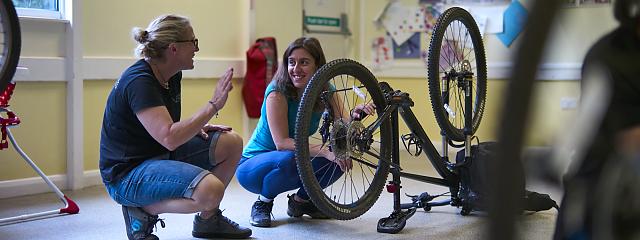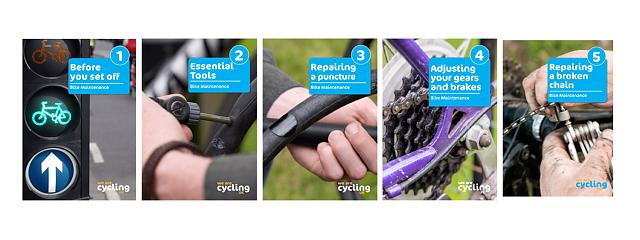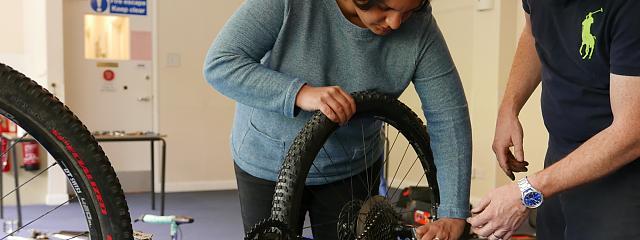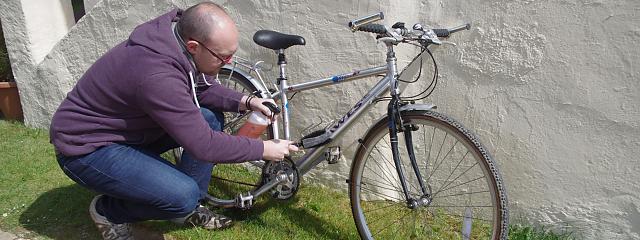How to look after your bike
How to look after your bike
Giving your bike a little TLC can be the difference between keeping it on the road and consigning it to the shed, never to be ridden again. But you don’t need to be a cycle mechanic to carry out simple checks and keep things moving. Just follow the advice below.
1. It’s as simple as ABC
Performing this easy ABC check before you go out on a ride will help prevent many a mechanical issue.
A is for air – keep the tyres pumped up and check the wheels go round unimpeded. If they don’t, look for brakes or mudguards rubbing or a possible sideways wobble of the wheel.
B is for brakes – the most important part of a bike. To check the front brake, push the bike forward and then apply the lever (usually the right-hand one). The bike should stop. For the back brake, do the same but push the bike backwards. If in doubt, get it checked
C is for chains, cables and cogs. Look for frayed cables, oil the chain, and check the handlebars and saddle don’t move. Look for anything unusual with the bike.
2. Keep it clean
Giving your bike a good clean will extend its life. You don’t necessarily need specialist products, but do regularly remove all dirt and grit. Remember to oil the bike chain after washing, allowing for it to dry first. A lovely, sparkly chain will soon creak otherwise.
3. Oil it
The main moving parts are the chain and cogs and they only need a light dab of oil – your watch words here are little and often. There are many products on the market. Light lubricant sprays work in the summer, while thicker oils deter the weather, especially in the winter. Just don’t use cooking or engine oil or WD40!
4. Learn to fix a puncture
Fixing the dreaded puncture might be tricky, but you can do it, following some standard steps. Practise at home first, maybe with a friend. Take your time. There’s no rush and it’s better to get things right first time, rather than having to do it twice. You’ll be amazed that after a few goes, you will be able to do it without too much bother. Our friends at BikeRadar have comprehensive step-by-step puncture repair videos for both road and mountain bike tyres.
5. Replace worn out parts of a bike
A bike has numerous moving parts and they are subject to quite significant forces; it’s inevitable that they’ll wear out over time. Be prepared to replace parts when needed. It’s a good investment for your beloved bike and will keep it in action for longer.
6. Go on a bike maintenance course
If you want to try to fix your bike yourself, but aren’t sure how to, look up your nearest bike maintenance course. Ask the provider exactly what they cover. You want friendly instructors who don’t blind you with science. If they do, they’re doing it wrong. Learning bike maintenance will save you lots of money in the future.
7. When to use a bike mechanic
You’ll be amazed at how much you can do at home to keep your bike roadworthy. It can be fiddly, but take your time and much of it is within your grasp.
A good bike maintenance book and lots of good advice from the Cycling UK Forum will help. When using Google (other search engines are available), compare a couple of sites to avoid poor advice. Just keep the hammer and Stanley knife away from the bike!
If you get stuck with something, it’s good to keep trying but don’t force it and don’t beat yourself up about it. There are good mechanics that can help and they’ve had training.
If you are in a hurry, or if the problem really stumps you, go to your nearest independent bike shop or call a mobile bike mechanic to come to you.
The most important thing is to get your bike back on the road and to enjoy cycling.
8. Ride your bike!
Riding your bike gets all the moving parts working and can delay and reduce any issues. Just keeping the chain and wheels moving will reduce rust and prevent the parts ceasing up.
9. Little and often is good
You don’t have to do a huge amount to keep your bike on the road. A regular check-over and a squirt of oil will help to keep many problems at bay.
10. Revive your bike
Finally, if your bike has been gathering dust in a garage or shed, get it out this summer and take it to our Big Bike Revival, where there will be experts on hand to help you fix your bike and learn how to look after it.
Just enjoy exploring the world on a bike, even if it’s just your local neighbourhood. And, remember you don’t have to be able to fix everything on a bike before you’re allowed to ride it. As long as it’s roadworthy, just get out there and do it!






